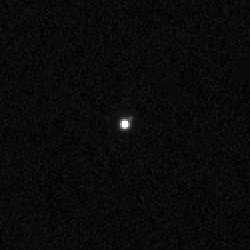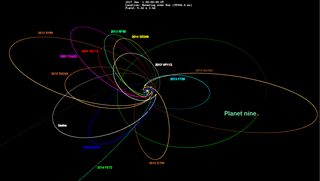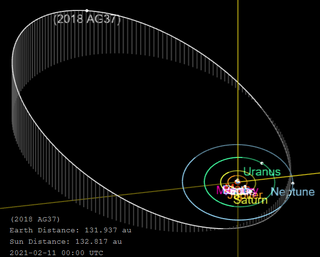(470308) 2007 JH43 (provisional designation 2007 JH43) is a trans-Neptunian object in the outer regions of the Solar System, approximately 500 kilometers in diameter. It was discovered on 10 May 2007, by the U.S. Palomar Observatory in California. The team of unaccredited astronomers at Palomar consisted of Megan E. Schwamb, Michael E. Brown and David L. Rabinowitz
(181902) 1999 RD215 is a trans-Neptunian object of the scattered disc, approximately 148 kilometers in diameter. It was discovered on 6 September 1999, by American astronomers Chad Trujillo, Jane Luu, and David Jewitt at the Mauna Kea Observatories, Hawaii.

(528381) 2008 ST291, provisional designation 2008 ST291, is a 1:6 resonant trans-Neptunian object located in the outermost region of the Solar System that takes almost a thousand years to complete an orbit around the Sun. It was discovered on 24 September 2008 by American astronomers Megan Schwamb, Michael Brown and David Rabinowitz at the Palomar Observatory in California, with no known earlier precovery images.
(589683) 2010 RF43 (provisional designation 2010 RF43) is a large trans-Neptunian object orbiting in the scattered disc in the outermost regions of the Solar System. The object was discovered on 9 September 2010, by American astronomers David Rabinowitz, Megan Schwamb and Suzanne Tourtellotte at ESO's La Silla Observatory in northern Chile.
2010 TJ is a trans-Neptunian object from the scattered disc in the outermost region of the Solar System and measures approximately 460 kilometers in diameter. It was first observed by American astronomers David Rabinowitz, Megan Schwamb, and Suzanne Tourtellotte at ESO's La Silla Observatory in northern Chile on 2 October 2010.

(60621) 2000 FE8 (provisional designation 2000 FE8) is a resonant and binary trans-Neptunian object, approximately 146 kilometers (91 miles) in diameter, located in the outermost region of the Solar System. It was discovered on 27 March 2000, by astronomers John Kavelaars, Brett Gladman, Jean-Marc Petit and Matthew Holman at Mauna Kea Observatory on Hawaii. This distant object resides in an eccentric orbit and is locked in a 2:5 orbital resonance with Neptune. It is known to have a 111-kilometer sized companion, which was discovered in January 2007.

2012 VP113, also known by its nickname "Biden", is a trans-Neptunian object of the sednoid population, located in the outermost reaches of the Solar System. It was first observed on 5 November 2012 by American astronomers Scott Sheppard and Chad Trujillo at the Cerro Tololo Inter-American Observatory in Chile. The discovery was announced on 26 March 2014. The object probably measures somewhere between 300 and 1000 km in diameter, possibly large enough to be a dwarf planet.

(532037) 2013 FY27 (provisional designation 2013 FY27) is a trans-Neptunian object and binary system that belongs to the scattered disc (like Eris). Its discovery was announced on 31 March 2014. It has an absolute magnitude (H) of 3.2. 2013 FY27 is a binary object, with two components approximately 740 kilometres (460 mi) and 190 kilometres (120 mi) in diameter. It is the ninth-intrinsically-brightest known trans-Neptunian object, and is approximately tied with 2002 AW197 and 2002 MS4 (to within measurement uncertainties) as the largest unnamed object in the Solar System.

(523692) 2014 EZ51 (provisional designation 2014 EZ51) is a large trans-Neptunian object in the scattered disc, approximately 700 kilometres (430 miles) in diameter. It was discovered on 18 April 2010, by the Pan-STARRS 1 survey at Haleakala Observatory, Hawaii, United States.

2015 RX245 is an extreme trans-Neptunian object, detached, on a highly eccentric orbit in the outermost region of the Solar System. It measures approximately 250 kilometers (160 miles) in diameter and is "possibly" a dwarf planet. It was first observed on 8 September 2015, by astronomers with Outer Solar System Origins Survey using the 3.6-meter Canada–France–Hawaii Telescope at Mauna Kea Observatories, Hawaii, in the United States.

2002 GB32, is a trans-Neptunian object from the scattered disc in the outermost region of the Solar System, approximately 122 kilometers in diameter. It was first observed on 7 April 2002, by American astronomer Marc Buie at Cerro Tololo Observatory in Chile.
2003 SS422 is a trans-Neptunian object located in the outermost region of the Solar System. It was discovered on 28 September 2003, by American astronomers at the Cerro Tololo Observatory in La Serena, Chile, and estimated to measure approximately 168 kilometers (104 miles) in diameter.

2013 FS28 is an extreme trans-Neptunian object from the extended scattered disc on a highly eccentric orbit in the outermost region of the Solar System. It measures approximately 466 kilometers (290 miles) in diameter. The detached, extended scattered disc object belongs to the group of extreme trans-Neptunian objects. It was first observed on 16 March 2013, by American astronomers Scott Sheppard and Chad Trujillo at the Cerro Tololo Observatory in Chile.
(527603) 2007 VJ305, provisional designation 2007 VJ305, is an extrem trans-Neptunian object from the extended scattered disc on a highly eccentric orbit in the outermost region of the Solar System. It measures approximately 250 kilometers (160 miles) in diameter and is "possibly" a dwarf planet. The rather reddish extended scattered disc object belongs to the group of extreme trans-Neptunian objects. It was discovered on 4 November 2007 by astronomers Andrew Becker, Andrew Puckett and Jeremy Kubica at the Apache Point Observatory in New Mexico, United States.
2013 UH15 is an extreme trans-Neptunian object from the extended scattered disc in the outermost region of the Solar System, approximately 130 kilometers (81 miles) in diameter. It was first observed on 29 October 2013, by astronomers at the Las Campanas Observatory in the southern Atacama Desert of Chile. The detached extended scattered disc object (ESDO) is on a highly eccentric orbit and belongs to the extreme trans-Neptunian objects.
2014 SS349 is an extreme trans-Neptunian and scattered disc object from the outermost regions of the Solar System, approximately 134 kilometers in diameter.
(543354) 2014 AN55 (provisional designation 2014 AN55) is a trans-Neptunian object in the scattered disc, located in the outermost region of the Solar System, that measures approximately 600 kilometres (370 mi) in diameter. It was discovered on 25 January 2014, by astronomers with the Pan-STARRS survey at Haleakala Observatory on the island of Maui, Hawaii, in the United States.
(495603) 2015 AM281 (provisional designation 2015 AM281) is a resonant trans-Neptunian object in the outermost region of the Solar System, guesstimated at approximately 470 kilometers (290 miles) in diameter. It was discovered on 13 March 2010, by astronomers with the Pan-STARRS survey at Haleakala Observatory, Hawaii, United States.

2018 AG37 is a distant trans-Neptunian object and centaur that was discovered 132.2 ± 1.5 AU (19.78 ± 0.22 billion km) from the Sun, farther than any other currently observable known object in the Solar System. Imaged in January 2018 during a search for the hypothetical Planet Nine, the confirmation of this object was announced in a press release in February 2021 by astronomers Scott Sheppard, David Tholen, and Chad Trujillo. The object was nicknamed "FarFarOut" to emphasize its distance from the Sun.

2017 FO161 is a large trans-Neptunian object from the scattered disc located in the outermost region of the Solar System. It is estimated to measure approximately 600 kilometers (370 mi) in diameter and currently orbits at a distance of about 78.5 AU from the Sun. The object was first observed by American astronomers Chad Trujillo and Scott Sheppard using the 4-meter Víctor M. Blanco Telescope at the Cerro Tololo Inter-American Observatory in Chile on 23 March 2017. Precovery observations were made by the Pan-STARRS-1 survey at Haleakalā Observatory and by the Dark Energy Survey with DECam, dating back as far as March 2012 and January 2016, respectively.










